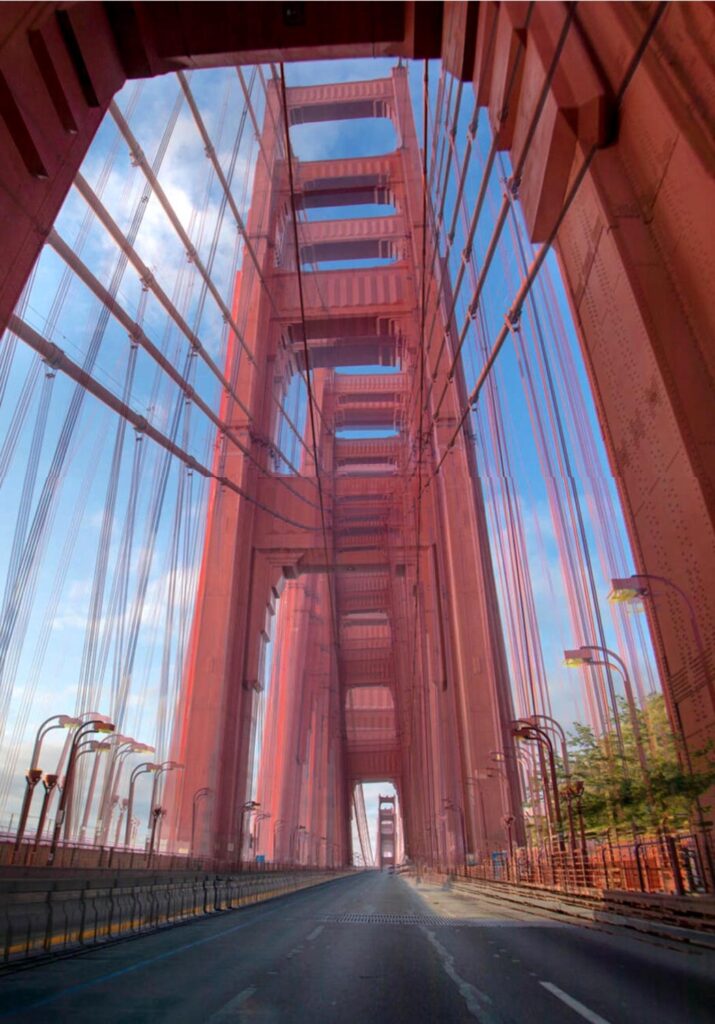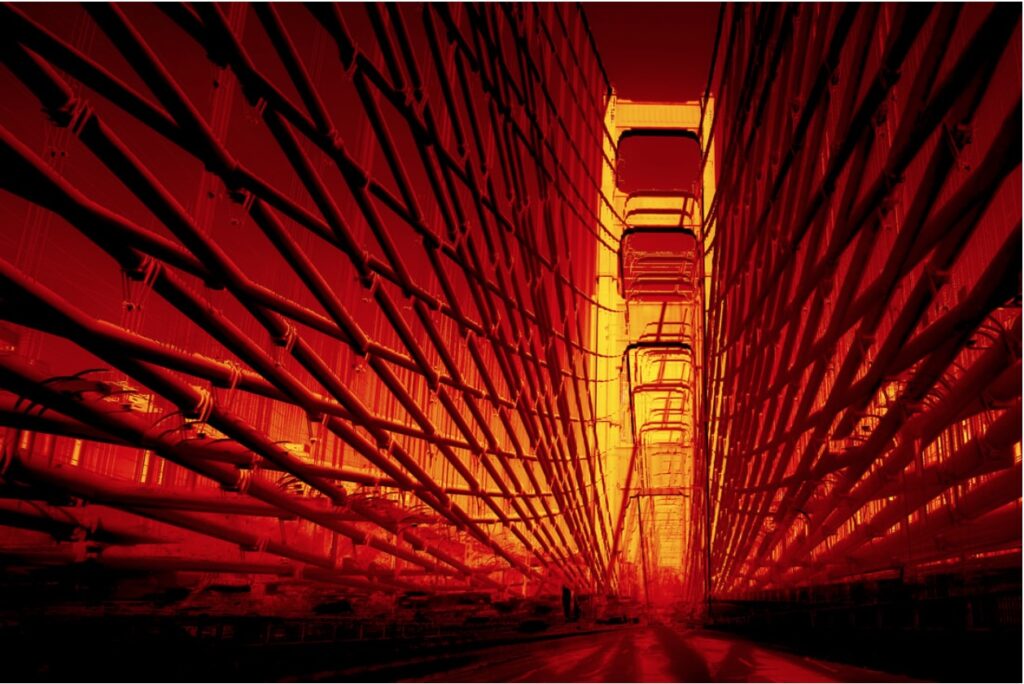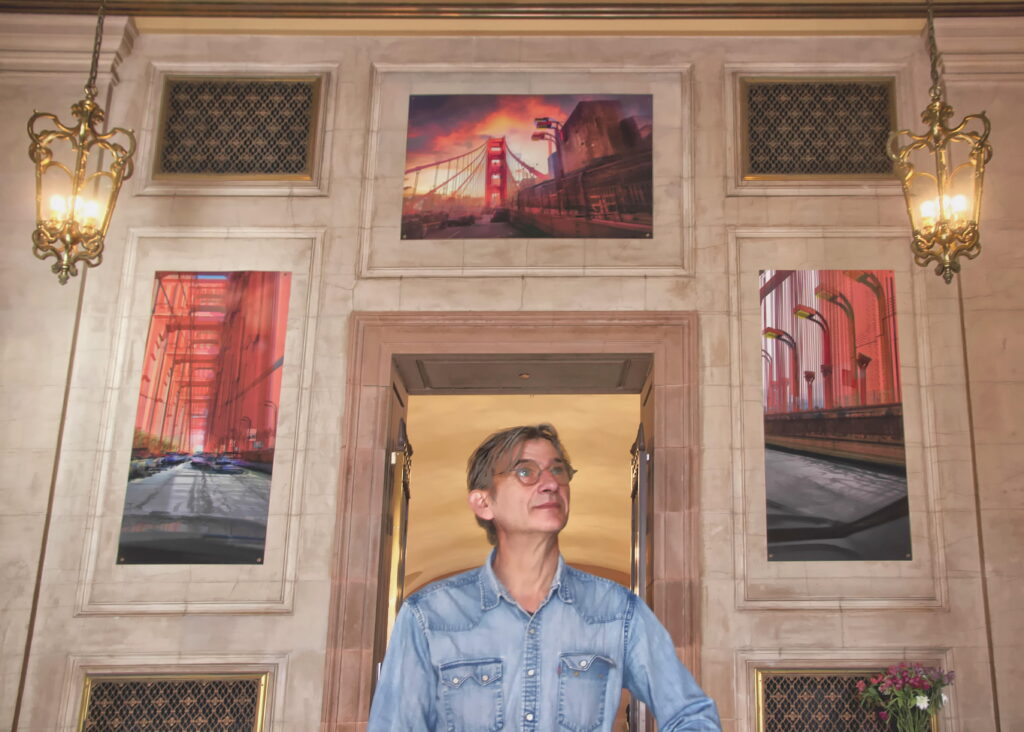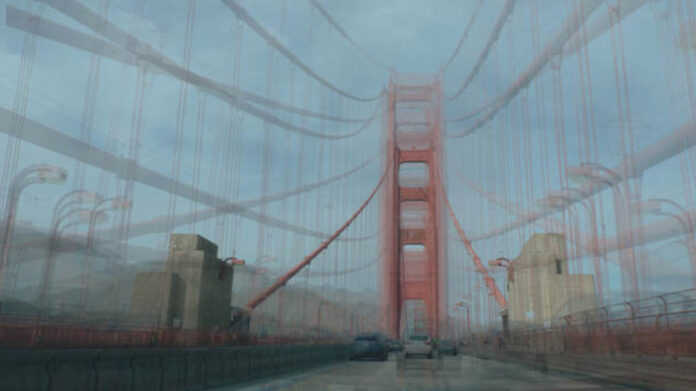Bay Area commuters jaded by routine may speed along the Golden Gate Bridge engrossed in the minutiae of daily life. But the striking photographs of Nico Van Dongen, whose No Delays show is now on view in the San Francisco War Memorial Veterans Building through Feb. 23, may convince them—er, us—to slow down and enjoy our local landmark with the fresh eyes of tourists.
The Dutch artist, a resident of the Bay Area since the early 1990s, has driven across the bridge for 25 years, marveling every time at the “magnificent monument.” Three years ago, he grabbed his Canon point-and-shoot, and, gripping the steering wheel with his right hand, snapped a sequence of images through his car window, at approximately one shot per second. Reviewing the photos later on his computer, the artist, a professor at UCSF, realized that the multiple images could be transformed into “photographic time sculptures” if they were made semi-transparent and carefully layered, with some features aligned but others out of register.

The resulting composites capture the dynamic bridge transit experience in a way that perfectly composed single images can not. The effect is vivid, even visionary, yet the means are simple: a car, a camera, a computer—and a sensibility honed on decades of photography.
Art mavens will remember that the depiction of time and change in city life was the subject of Cubist and Futurist painters in Europe a century ago. The French Cubists analyzed still-life subjects, faceting space into crystalline planes and combining multiple views to create a new reality of shifting perceptions. The Italian Futurists exalted speed and the machine, reacting against their country’s industrial backwardness and worship of tradition by infusing energy, and exalting aesthetic violence. Here in the New World, Joseph Stella’s Cubo-Futurist 1919-1920 painting of the Brooklyn Bridge depicted that structure as composed of transparent planes, both ephemeral and monumental.
Van Dongen’s bridge photography follows this modernist painting tradition while employing contemporary technology and aesthetics. For the artist, every grab-shot bridge drive is an adventure in “harvesting images,” an unpredictable collaboration with traffic and weather. The sparse bridge traffic during the pandemic was a creative benediction for Van Dongen, a green light from the art powers to proceed freely without delays: without slowing, stopping or careful cropping per his early photographic training; to boldly go into new creative territory.

(For safety’s sake, road worriers, be assured that the artist keeps his eyes on the road—“I don’t have to look through the viewfinder”—and he enlists his wife as driver when he uses an unwieldy DSLR instead of his lower-resolution Canon or cell phone.)
Included in No Delays are six large color composite photos on paper, mounted to the American Legion Veterans Gallery paneled marble walls with magnets; No Delays, a large print on silk, hanging in a large south-facing window; and, inside the display cases normally used for military memorabilia, eight untitled monochrome photos printed in black and red over backgrounds of International Orange. The large-scale photos depict the huge mass of the bridge, but they also, with their multiple semi-transparent layers, dematerialize it and elevate it into a metaphorical cathedral (for cars and drivers). For Van Dongen, they’re double-edged or contradictory metaphors, as he says:
Bridges symbolize the human spirit of perseverance, innovation, and the desire to connect people…. The paradoxical nature of bridges is that they simultaneously connect and isolate…. They can symbolize the barriers that separate people and the effort required to overcome this barriers.
For the show’s curator, Yolanda Faye, veteran and community activist, as well as recent UCSF Museum Studies graduate, the photographs are an important part of a discussion about mental health, particularly about veterans’, because of the bridge’s unfortunate history of suicides—now numbering some 1700, and hopefully dissuaded by newly erected suicide barriers. Van Dongen’s poetic images, in her words, create “a narrative that intertwines the bridge’s majesty with stories of human connection, loss, and resilience.”
Help us save local journalism!
Every tax-deductible donation helps us grow to cover the issues that mean the most to our community. Become a 48 Hills Hero and support the only daily progressive news source in the Bay Area.

The Heart and Armor Foundation and the Cesar E. Chavez American Legion Post 505 are sponsors of the show, and Faye seeks additional partnerships to raise awareness of the mental health issue through its reclaimed International Orange symbol, “a silent sentinel ‘neath changing skies,” to quote her poem, “No Delays.” You can get involved here.
NO DELAYS runs through Feb. 23 in room 102 of the War Memorial Veteran’s Building, SF. More info here.






